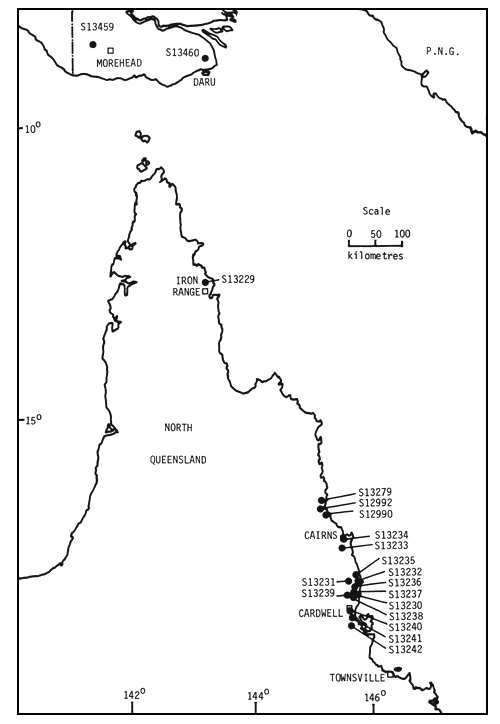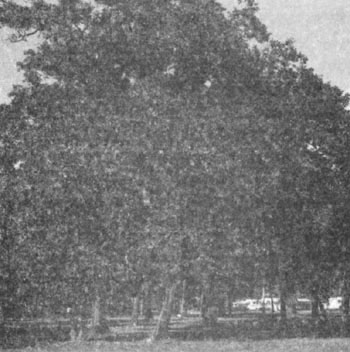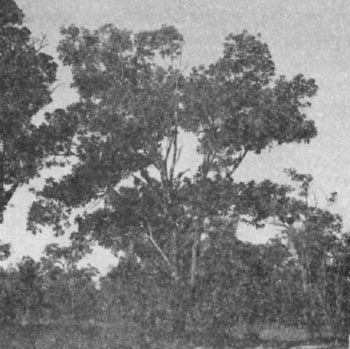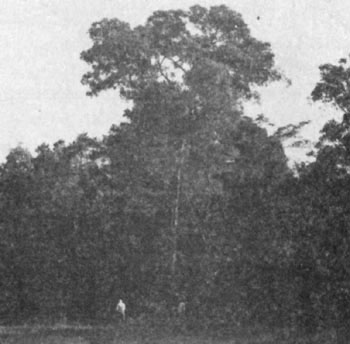by
J.C. Doran 1 and D.J. Skelton 2
SUMMARY
During 1980, seed collections of provenances of Acacia mangium Willd. were undertaken by the Division of Forest Research, CSIRO, Australia and the Office of Forests, Papua New Guinea from throughout a substantial part of the known natural occurrence of this species. This article details these and earlier collections, and discusses seed availability for international provenance trials.
INTRODUCTION
In its natural habitat Acacia mangium Willd. is often a large tree, up to 25–30 m tall, with a straight bole which may be over half of the total tree height. The species occurs in disjunct populations extending from northeast Queensland through southern Papua New Guinea to Indonesia (Irian Jaya and the southern Moluccas). The range of latitude is from about 1° to 19° S with the altitude of the main occurrence of this species from near sea-level to 100 m and a known upper limit of 720 m (Gadgarra, Queensland).
A. mangium is typically a low elevation species occurring in areas just behind the mangrove zone, in seasonal swamps, along streams, on well drained flats, on low ridges and on mountain foothills. It often occurs on the margins of mature rainforest and is found frequently on soil of low fertility. For further details on the distribution see Hall et al. 1980, Nicholson 1980, and Tham 1980.
Table 1 summarises the climate for a few representative stations in Australia and Papua New Guinea. The distribution is mainly in the humid, tropical climatic zone with short winter dry season and high total annual rainfall. Temperatures near the coast are high and equable throughout the year. The 50 percentile rainfall is around 2100 mm, the 10 percentile about 1300 mm. Nicholson (1980) states that A. mangium favours high rainfall sites (i.e. >2000 mm), and suggests that the disjunctions in the species distribution might be directly associated with rainfall patterns.
A. mangium was originally introduced into Sabah, Malaysia, in 1967 as a firebreak species but has now been adopted as the principal plantation species for grassland sites. A plantation area of 5000 ha had been established to 1980, with large areas planned for the future (Tham 1980). Factors contributing to its success are its fast growth rate, ability to grow on degraded soils of Imperata cylindrica L. grasslands, vigorous coppicing capacity, early heavy seed crops, and the suitability of its wood for a wide range of products including joinery, building material, particle board and paper pulp.
Since the publication of the success of the Sabah plantings (Tham 1976, -79, -80; Tham and Liew 1977; N.A.S. 1979) there has been a growing demand for seed of A. mangium for introductory trials from throughout tropical Asia, the Pacific Islands and West Africa. Tham (1979) reported that most of the A. mangium planted in Sabah was derived from a single parent tree near Mission Beach, Queensland and called for comprehensive provenance trials of the species before too large an area of plantation is established from this extremely limited genetic base.
In view of the potential value of the species, FAO recommended in 1979/82 that special attention be given to A. mangium in the Organization's cooperative seed collection programmes with the CSIRO Division of Forest Research, Australia and the Office of Forests, Papua New Guinea, with a view of the early establishment of international provenance trials. FAO has also approached the Directorate-General of Forestry, Indonesia with a request for cooperation in sampling of the Indonesian part of the natural range of the species. In addition to FAO, the Sabah Government also provided funds to the Office of Forests to undertake collections of Acacia mangium in western Papua on their behalf.
1 Division of Forest Research, CSIRO, P.O. Box 4008, Canberra A.C.T. 2600, Australia.
2 Office of Forests, P.O. Box 2116, Yomba, Madang, Papua New Guinea.
SEED COLLECTIONS
In Australia the main collections took place in northern Queensland during October and November 1980. Seed was obtained from 136 trees in 15 provenances. Together with two provenances (S12990 and S12992; 13 trees) sampled in 1979, these collections give a substantial coverage of the natural range of A. mangium in Australia (see Fig.1 and Table 2). Approximately half of the seed has been kept separate by individual trees and the remainder bulked by provenance. Most of the collections were made by climbing and cutting down seed-bearing limbs. Photographs of trees in four Australian stands are given in Figure 2.
Papua New Guinea seedlots were collected in October 1980 from two provenance areas; one between the Morehead and Bensbach Rivers (S13459) and the other along the middle reaches of the Oriomo River (S13460). In all, seed was obtained from 133 trees (see Table 2). Part of the seed was bulked by provenance for the international provenance trials.
SEED AVAILABILITY
Seed will be made available during 1983 for international provenance trials to be established under the auspices of FAO and co-ordinated by CSIRO. It is likely that some provenances to be collected by the Directorate-General of Forestry, Indonesia, will also be included in these trials. FAO will contact its member Governments when the seed is available for distribution. However, Departments and Institutes interested in participating in the planned international trials can preliminarily contact the Forest Resources Division of FAO's Forestry Department (Via delle Terme di Caracalla, 00100 Rome, Italy) providing, in advance, the following information:
is it intended to establish trials on more than one site and if so, how many?
are facilities available to test the full range of provenances 1 on all sites or part thereof or would a smaller number of provenances be more appropriate? If only limited trials are envisaged please provide detailed site information so that a selection can be made.
have species/provenance trials of A. mangium or other tropical acacias already been successfully established on the proposed site(s) or similar ones nearby ? If so, what are the indications of these trials?
in which month would you wish to receive the seed?
are special import permits needed for research quantities of seed?
The institutes in charge of the collections are: Office of Forests, P.M.B. 5054, Boroko, Papua New Guinea; Directorate-General of Forestry, Jalan Salemba Raya 16, Jakarta, Indonesia; and CSIRO Division of Forest Research, P.O. Box 4008, Canberra A.C.T. 2600, Australia.
1 A total of between 20 and 30 provenances are likely to be available for testing.
REFERENCES
Hall, N., Turnbull, J.W., Doran, J.C. and Martensz, P.N. 1980 “Acacia mangium”. Aust. Acacia Series Leaflet No. 9.
N.A.S. 1979 “Tropical Legumes: Resources for the Future”. National Academy of Sciences: Washington, D.C. 331 pp.
Nicholson, D.I. 1980 Report on the natural occurrence and status of Acacia mangium Willd. in Australia. Paper to the IUFRO Symposium and Workshop on Genetic Improvement and Productivity of Fast-Growing Tree Species, Sao Paulo, Brazil, August 1980.
Tham, C.K. 1976 Introduction to a plantation species - Acacia mangium Willd. Sixth Malaysian Forestry Conference. Kuching, Sarawak.
Tham, C.K. 1979 Trials of Acacia mangium Willd. as a plantation species in Sabah. Forest Genetic Resources Information No. 9, FAO, Rome.
Tham, C.K. 1980 Acacia mangium Willd. - a plantation species for Imperata cylindrica (L.) Beauv. grassland in Sabah. Paper to the IUFRO Symposium and Workshop on Genetic Improvement and Productivity of Fast-Growing Tree Species, Sao Paulo, Brazil, August 1980.
Tham, C.K., and Liew, T.C. 1977 Prospects of forest plantation in the tropics with particular reference to Sabah. Pulp and Paper Seminar. Kuching, Sarawak.
TABLE 1. CLIMATIC DATA FOR METEOROLOGICAL STATIONS CLOSE TO ACACIA COLLECTION SITES IN AUSTRALIA AND PAPUA NEW GUINEA
| Station location details | Temperature (°C) | Mean monthly rainfall (mm) | Mean annual rainfall (mm) | |||||||||||||||||
| Name | Lat. (°S) | Long. (°E) | Altitude (m) | January | July | J | F | M | A | M | J | J | A | S | O | N | D | |||
| Mean min. | Mean max. | Mean min. | Mean max. | |||||||||||||||||
| Cardwell | 18°16' | 146°02' | 6 | 23 | 32 | 13 | 25 | 457 | 466 | 417 | 211 | 92 | 50 | 33 | 29 | 36 | 52 | 107 | 193 | 2143 |
| Cairns | 16°53' | 145°45' | 3 | 24 | 32 | 17 | 25 | 421 | 422 | 460 | 264 | 110 | 72 | 39 | 42 | 43 | 50 | 98 | 203 | 2224 |
| Morehead | 8°43' | 141°38' | 31 | - | - | - | - | 332 | 262 | 318 | 157 | 154 | 86 | 54 | 52 | 38 | 80 | 114 | 224 | 1913 |
| Daru | 9°04' | 143°12' | 8 | 23 | 32 | 22 | 29 | 280 | 258 | 325 | 321 | 223 | 108 | 93 | 52 | 42 | 55 | 111 | 204 | 2063 |
TABLE 2. PROVENANCE LOCATION WITH SOME PARENT TREE AND SEED DATA FOR COLLECTIONS OF ACACIA MANGIUM IN AUSTRALIA AND PAPUA NEW GUINEA
| CSIRO seedlot no. | Provenance location | Lat. (°S) | Long. (°E) | Alt. (m) | Details of trees within provenance | Seed viability/10 g of cleaned seed | |||
| No. | Mean height (m) | Mean dbh (cm) | |||||||
| S12990 | Julatten | Qld | 16°34' | 145°25' | 400 | 5 | 14 | 28 | 660 |
| S12992 | Rex Range | Qld | 16°30' | 145°22' | 30 | 8 | - | - | 770 |
| S13230 | Mission Beach | Qld | 17°53' | 146°06' | 2 | 10 | 15 | 47 | 300 |
| S13231 | Silkwood | Qld | 17°42' | 145°57' | 40 | 5 | 15 | 31 | 230 |
| S13232 | Cowley Beach | Qld | 17°41' | 146°05' | 5 | 10 | 8 | 22 | 410 |
| S13233 | Walsh's Pyramid | Qld | 17°06' | 145°48' | 20 | 10 | 9 | 42 | 670 |
| S13234 | Trinity Inlet | Qld | 17°02' | 145°48' | 20 | 10 | 15 | 38 | 500 |
| S13235 | Mourilyan Bay | Qld | 17°35' | 146°05' | 20 | 5 | 11 | 28 | 400 |
| S13236 | Kurrimine | Qld | 17°46' | 146°05' | 10 | 5 | 7 | 22 | 80 |
| S13237 | El Arish | Qld | 17°50' | 146°01' | 20 | 10 | 10 | 35 | 230 |
| S13238 | E. of Tully | Qld | 17°56' | 146°02' | 70 | 10 | 21 | 48 | 420 |
| S13239 | W. of Tully | Qld | 17°55' | 145°52' | 50 | 10 | 15 | 40 | 400 |
| S13240 | Cardwell | Qld | 18°14' | 145°58' | 60 | 5 | 23 | 49 | 550 |
| S13241 | Broken Pole Ck | Qld | 18°21' | 146°03' | 50 | 5 | 20 | 18 | 640 |
| S13242 | Abergowrie | Qld | 18°26' | 146°01' | 60 | 10 | 12 | 31 | 600 |
| S13229 | Claudie R. | Qld | 12°44' | 143°13' | 60 | 6 | 24 | 52 | 500 |
| S13279 | Daintree | Qld | 16°17' | 145°31' | 60 | 25 | - | - | 660 |
| S13459 | W. of Morehead | PNG | 8°39'– 8°52' | 141°18'– 141°30' | 30 | 100 | 22 | 32 | - |
| S13460 | Oriomo R. | PNG | 8°50' | 143°08' | 10 | 33 | 20 | 35 | - |
FIGURE 1. 1979 AND 1980 ACACIA MANGIUM COLLECTION SITES IN AUSTRALIA AND PAPUA NEW GUINEA

FIGURE 2. ACACIA MANGIUM SEED TREES AT FOUR COLLECTION SITES IN AUSTRALIA
 |  |
| (i) Part of the population at Mission Beach, S13230 | (ii) A small road-side tree at Kurrimine, S13236 |
 |  |
| (iii) Trees on rainforest margin east of Tully, S13238 | (iv) A 30 m tree of good form northwest of Cardwell, S13240 |
Manuscript received in March 1982.